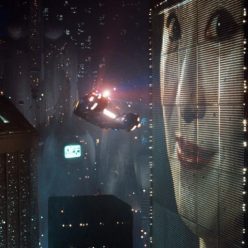I’ve included two small clips from the series ‘Black Mirror’ and the first episode of its third season, Nosedive. The entire episode is well worth the watch, but as it’s a 50 minute long sequence I didn’t want to post the full thing. The story follows Lacie in a society where people are given merit by ratings given through encounters and experiences. These ratings, visible to everyone through contact lenses and on a 5-star scale, allow the more elite members rights and access to certain services, while a lower rating leads to restriction and scorn. Lacie, rated on a 4.2 average, is looking to reach a 4.5 in order to move into a new, luxurious apartment, and takes any measure to gain respect to boost her up. Both clips take place at the start of the episode, setting the scene for the premise. The first clip, though short, has a huge influence and connection to my film – it depicts Lacie looking in the mirror, working on her laugh to sound more appealing. She picks apart how she must act for the day, stressing how much someone’s appearance and demeanor really matters.
The second clip is a step further, revealing others’ ratings at a local cafe, showing the effort put in to have a perfect-looking lifestyle. Lacie painstakingly takes a bite out of a biscuit to make it look pristine for a picture. The light, breezy pastels and soothing music lead us to believe everything is fine, and at this point in the episode, that’s very true. It almost feels like everyday life for us.
Most of the story is relevant to my film. I want to focus on how a simple daily routine affects people – as simple as looking in the mirror and getting ready to go out. As simple as feeling self-conscious in public, fretting over what others think of you. My own film opens with a shot similar to the first clip – a look in the mirror and the concern of how you’re perceived.
While Nosedive is rooted in the dark side of technology, it’s all a paralleled message. What is more, from the start, I wanted to have a colorful and bright film, just as Nosedive has. The pastels draw us in, the score relaxes us. The entire cinematography shapes a film. That to me is important, and what leaves a viewer with a lasting impression. Nosedive itself sticks out from the other episodes of ‘Black Mirror’ because it is brighter while the others are based in a dark color scheme. I don’t want to distract from the message of my film, I’d just like to visually enhance it to make it more desirable to watch.
